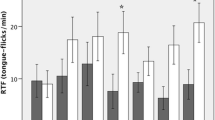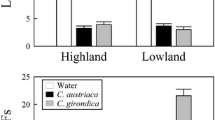Abstract
Newborn of two locally sympatric species of water snakes,Nerodia fasciata andN. erythrogaster, were exposed to skin extracts of frequently ingested prey. In southern Louisiana, fish account for 78% of the diet of adultNerodia fasciata and about 15% forNerodia erythrogaster. Anurans comprise most of the remainder of the diets of these water snakes. Responses of naive individuals were compared to the chemoreceptive response profiles of groups of snakes reared on limited diets of fish and/or frogs. All snakes were tested seven times over a nine-month period and ontogenetic changes were apparent. NewbornNerodia fasciata have a strong chemoreceptive response for fish extract that remains unchanged by early dietary restrictions for the first six months of life. After that time their responses are more variable and can be altered by recent feeding experience. In southern Louisiana, this species is the least specialized water snake, an observation supported by these laboratory results. While newbornN. erythrogaster did not respond preferentially to any of the prey extracts, a significant response rate for fish extract is established by two months of age that persists for several months regardless of dietary restrictions. A subsequent shift of the response to frog extract at eight months of age regardless of diet may reflect a maturational process. Field studies are in agreement with these results and support the notion of ontogenetic changes related to predator size and age. This is the first demonstration of an ontogenetic change in chemoreceptive response that is not related to dietary experience.
Similar content being viewed by others
References
Arnold, S.J. 1978. Some effects of early experience on feeding responses in the common garter snake,Thamnophis sirtalis. Anim. Behav. 26:455–467.
Burghardt, G.M. 1966. Stimulus control of the prey-attack response in naive garter snakes.Psychon. Sci. 4:37–38.
Burghardt, G.M. 1967. Chemical-cue preferences of inexperienced snakes: Comparative aspects.Science 157:718–721.
Burghardt, G.M. 1968. Chemical preference studies on newborn snakes of three sympatric species ofNatrix. Copeia 1968:727–737.
Burghardt, G.M. 1969. Comparative prey-attack studies in newborn snakes of the genusThamnophis. Behaviour 33:77–114.
Burghardt, G.M. 1970. Intraspecific geographical variation in chemical food cue preference of newborn garter snakes(Thamnophis sirtalis). Behaviour 34:246–257.
Burghardt, G.M. 1975. Chemical prey preference polymorphism in newborn garter snakesThamnophis sirtalis. Behaviour 52:202–225.
Burghardt, G.M., andPruitt, C.H., 1975. Role of the tongue and senses in feeding of naive and experienced garter snakes.Physiol. Behav. 14:185–194.
Czaplicki, J.A., andPorter, R.H., 1974. Visual cues mediating the selection of goldfish (Carassius auratus) by two species ofNatrix.J. Herpetol. 8:129–134.
Diener, R.A. 1957. An ecological study of the plain-bellied water snake.Herpetologica 13:203–211.
Dix, M.W. 1968. Snake food preference: Innate interspecific geographic variation.Science 159:1478–1479.
Dunbar, G.L. 1979. Effects of early feeding experience on chemical preference of the northern water snake,Natrix s. sipedon (Reptilia, Serpentes, Colubridae).J. Herpetol. 13:165–169.
Fuchs, J.L., andBurghardt, G.M. 1971. Effects of early experience on the responses of garter snakes to food chemicals.Learning Motivation 2:271–279.
Gove, D., andBurghardt, G.M. 1975. Responses of ecologically dissimilar populations of the water snakeNatrix s. sipedon to chemical cues from prey.J. Chem. Ecol. 1:35–40.
Hebrard, J.J., andMushinsky, H.R. 1978. Habitat use by five sympatric water snakes in a Louisiana swamp.Herpetologica 34:306–311.
Klopfer, P.H. 1973. Behavioral Aspects of Ecology. 2nd ed. Prentice-Hall, Englewood Cliffs, New Jersey.
Kofron, C.P. 1978. Foods and habitats of aquatic snakes (Reptilia, Serpentes) in a Louisiana swamp.J. Herpetol. 12:543–554.
Mushinsky, H.R. andHebrard, J.J. 1977a. Food partitioning by five species of water snakes in Louisiana.Herpetologica 33:162–166.
Mushinsky, H.R., andHebrard, J.J. 1977b. The use of time by sympatric water snakes.Can. J. Zool. 55:1545–1550.
Porter, R.H. andCzaplicki, J.A.; 1977. Evidence for a specific searching image in hunting water snakes (Natrix sipedon) (Reptilia, Serpentes, Colubridae).J. Herpetol. 11:213–216.
Preston, W.B. 1970. The comparative ecology of two water snakes,Natrix rhombifera andNatrix erythrogaster, in Oklahoma. Ph. D. dissertation, University of Oklahoma, Norman. (Diss. Abst. No. 70-14, 426).
Rossman, D.A., andEberle, W.G. 1977. Partition of the genusNatrix with preliminary observations on evolutionary trends in natricine snakes.Herpetologica 33:34–43.
Author information
Authors and Affiliations
Rights and permissions
About this article
Cite this article
Mushinsky, H.R., Lotz, K.H. Chemoreceptive responses of two sympatric water snakes to extracts of commonly ingested prey species. J Chem Ecol 6, 523–535 (1980). https://doi.org/10.1007/BF00987665
Received:
Revised:
Issue Date:
DOI: https://doi.org/10.1007/BF00987665




